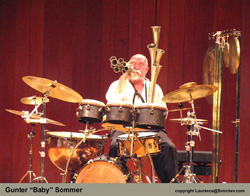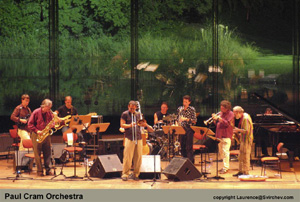Text © Stuart Broomer, Photography ©Laurence Svirchev
Jazz em Agosto—Jazz in August—is a festival with any number of differences, an event that in recent years has spanned a few days or two weeks, presenting both the celebrated and the little-known with the emphasis on innovative work. The festival is sponsored by the Gulbenkian Foundation, part of the extraordinary legacy of Calouste Gulbenkian whose name adorns the museum and art gallery that house the festival and also the park that surrounds them all. The festival’s concerts are scaled to the available halls, ranging from a small, almost vertical, lecture hall to a concert hall extraordinary for both its physical beauty and acoustics.
What makes all of this most remarkable is the creative vision of artistic director Rui Neves, who often programs the festival to emphasize a single country’s music. This year half of the festival’s 12 performances were devoted to Canadians, including four performances that provided an international forum for groups from the fertile Vancouver scene. The festival was bracketed by big bands from Canada’s opposite coasts, opening on Tuesday with Vancouver’s NOW Orchestra conducted by George Lewis and ending on Sunday with the Paul Cram Orchestra made up of musicians from Southern Ontario to Nova Scotia. The symmetry was highlighted by the two concerts taking place in the Gulbenkian’s stunning concert hall, the only night-time performances brought indoors by the threat of rain. The evening concerts in between took place in the outdoor Anfiteatro, another gorgeous setting for music and one taking advantage of Lisbon’s balmy August evenings.
In addition to Neves’ geographic theme, there seemed to be a historical theme—three of the festival’s most prominent groups strongly referenced the jazz history of the ‘60s and ‘70s in ways that variously suggested post-modern appropriation and irony rather than simple homage.
 The Thing—Mats Gustafsson on tenor and baritone saxes, drummer Paul Nilssen-Love and bassist Ingebrigt Haker-Flaten—is a group of tremendous energy and co-ordination, in effect raising the bar on “energy music” traditions with extraordinarily rapid and accurate shifts between free-improv and composed sections executed via cuing. Gustafsson plays baritone saxophone with the same brilliant fluency that he displays on tenor and his partners are in perfect synch. The performance was genuinely exciting and cathartic as well, including a special homage to Albert Ayler’s trumpeters that included Don Ayler’s “Our Prayer” and Norman Howard’s “Hounded” (the latter played in memory of Steve Lacy), in a program that also transformed current pop songs (P.J Harvey, White Stripes) and Scandinavian folk songs. It is, however, in its very co-ordination that the group becomes problematic, sometimes rendering a music of great spiritual depth with the precision and machismo of a Marine drill. Cathartic, yes, but also unsettling.
The Thing—Mats Gustafsson on tenor and baritone saxes, drummer Paul Nilssen-Love and bassist Ingebrigt Haker-Flaten—is a group of tremendous energy and co-ordination, in effect raising the bar on “energy music” traditions with extraordinarily rapid and accurate shifts between free-improv and composed sections executed via cuing. Gustafsson plays baritone saxophone with the same brilliant fluency that he displays on tenor and his partners are in perfect synch. The performance was genuinely exciting and cathartic as well, including a special homage to Albert Ayler’s trumpeters that included Don Ayler’s “Our Prayer” and Norman Howard’s “Hounded” (the latter played in memory of Steve Lacy), in a program that also transformed current pop songs (P.J Harvey, White Stripes) and Scandinavian folk songs. It is, however, in its very co-ordination that the group becomes problematic, sometimes rendering a music of great spiritual depth with the precision and machismo of a Marine drill. Cathartic, yes, but also unsettling.
Otomo Yoshihide’s New Jazz Quintet–on this occasion featuring Gustafsson as special guest—might elicit a range of responses and did, from one critic who could happily speak of “grooving to it” to a composer who left early, remarking his ears were too valuable to subject them to that kind of assault. Yoshihide’s group is a multiple homage to the ‘60s and therein lies its special difficulties. It’s an excellent free jazz ensemble devoted –on this occasion–to repertoire by Mingus (“Orange”), Coleman, Dolphy (“Hat and Beard”) and Charlie Haden’s Liberation Music Orchestra. Yoshihide is an interesting presence when comping on guitar–imaginative, dissonant, fresh. Then came the guitar solos—unaccompanied (what might a rhythm section do?) walls of feedback, monumental in the manner of Jimi Hendrix, but also inert. The first of these—with Coleman’s “Lonely Woman” standing in for the “Star Spangled Banner”–was imaginative and surprising, but Yoshihide’s other solos followed the same pattern. Anthemic ironies aside, I could never feel the two halves of the performance in anyway cohere, leaving instead a statement about compound nostalgias.
In the midst of this altoist Kenta Tsugami was a brilliant presence. Initially overshadowed by Gustafsson’s more extrovert effects, Tsugami eventually ranged from the subtly evasive to sustained and incendiary playing, inspiring the rhythm section of bassist Hiraki Mizutani and drummer Yasuhiro Yoshigaki to their finest work of the night—complex, interactive, fully engaged.
The Thing and Yoshihide’s group recalled for me John Zorn’s Spy vs. Spy, his hyper-kinetic treatment of Ornette Coleman compositions. What, I thought then, had Ornette done to deserve this? And in Lisbon I wondered at times what had Albert Ayler (and Dolphy and Hendrix, et al.) done to deserve these double-edged tributes? I think it’s that their work remains so central and powerful that musicians either ignore or attack it (odd that Wynton Marsalis contributes “remarks” at the presentation of this year’s Lillian Gish Award to Coleman), play slavish if limited imitations (the pathos of much current free jazz), or try—as do Gustafsson, Yoshihide, Zorn, et al–to find ways to express the real complexity of the current relationship to that music. One explanation might be found in Harold Bloom’s “Anxiety of Influence,” the notion that strong poets advance by misunderstanding their forebears. It’s a fundamentally Oedipal theory of cultural progress, especially apparent when there’s as much love, violence and irony as Gustafsson and Yoshihide were serving up. The source music is anathematized, both blessed and cursed.
Viennese trumpeter Franz Hautzinger’s Regenorchester XI may have been the most fascinating of these groups, certainly the subtlest and most surprising. Hautzinger’s recordings (on Grob) are brilliant exercises in an attenuated minimalist improvisation—in which instruments’ sounds are often stretched beyond recognition. While I tried to imagine how this might play to a large audience (Lisboans are the most intrepid listeners) on a Saturday night in the Anfiteatro, Hautzinger presented an entirely different—and apparently unrecorded–side of himself with a sextet rooted in Miles Davis’ early-to-mid ‘70s adventures in funk and fusion. It, too, was homage with a difference, the difference again manifesting itself in a strangely heterodox band: bassist Luc Ex (from the Amsterdam anarcho-punk-improv band The Ex) and drummer Alex Deutsch laid down raw and rugged funk beats while Christian Fennesz on laptop and Helge Hinteregger on sampling machine provided cool electronic frames for the leader’s abstract trumpet. Guitarist Karl Ritter paced the stage, literally shifting membership from the abstract to the funk components of the band. Description ultimately fails here, for the Hautzinger band did something quite extraordinary, at times presenting musics that seemed perfectly in step with each other—and perfectly clear–but which this listener at any rate couldn’t conceptualize a relationship between. It spoke of a special insight into Miles Davis and, more importantly, how you might put contemporary music together. For that I’m willing to declare it the most engaging and meaningful performance I’ve seen this year.
Solos
 The solo performance by Gunter “Baby” Sommer was an unalloyed delight, a brilliant and witty journey into Sommer’s life from percussion to the skewed world of East German politics and society in which he began his career Sommer’s gifts as a raconteur almost matched his wonderful drumming as he played a patchwork of jazz styles and African rhythms, often accompanying himself on voice and in one memorable sequence, a collection of bizarre homemade horns that he claimed were traditional East German instruments found abandoned in a field.
The solo performance by Gunter “Baby” Sommer was an unalloyed delight, a brilliant and witty journey into Sommer’s life from percussion to the skewed world of East German politics and society in which he began his career Sommer’s gifts as a raconteur almost matched his wonderful drumming as he played a patchwork of jazz styles and African rhythms, often accompanying himself on voice and in one memorable sequence, a collection of bizarre homemade horns that he claimed were traditional East German instruments found abandoned in a field.
Norwegian trumpeter Arve Henriksen made thoughtful use of his native folk materials and a battery of electronic devices along with his voice and sometimes two trumpets. It was Henriksen’s concentration on mood and melodic values that made all of this hold together, providing focus in a concert that might have just wandered into effects.
Conclusions
 The final concert by the Paul Cram Orchestra was a rare opportunity to hear this band amidst genuinely sparkling acoustics. It highlighted the leader’s acute sense of voicings and texture, adding sonic detail to the sweep of his compositions. Like all good jazz orchestrators, Cram is inspired by the sounds of his musicians, making felicitous use of Don Palmer’s flute and soprano with the darker, grainy hues of John Scott’s cello, Jeff Reilly’s bass clarinet and Tom Walsh’s wide ranging trombone palette, from vocalic mutes to gravelly lows and clarion highs. Walsh and Cram, playing gruffly rambunctious tenor, were responsible for the solo highlights. With Cram’s eclectic and cinematic compositions, the two themes of the festival—the post-modern and the Canadian—seemed to be drawn neatly together.
The final concert by the Paul Cram Orchestra was a rare opportunity to hear this band amidst genuinely sparkling acoustics. It highlighted the leader’s acute sense of voicings and texture, adding sonic detail to the sweep of his compositions. Like all good jazz orchestrators, Cram is inspired by the sounds of his musicians, making felicitous use of Don Palmer’s flute and soprano with the darker, grainy hues of John Scott’s cello, Jeff Reilly’s bass clarinet and Tom Walsh’s wide ranging trombone palette, from vocalic mutes to gravelly lows and clarion highs. Walsh and Cram, playing gruffly rambunctious tenor, were responsible for the solo highlights. With Cram’s eclectic and cinematic compositions, the two themes of the festival—the post-modern and the Canadian—seemed to be drawn neatly together.
Jazz em Agosto is a festival that one recommends without hesitation. Very different from the endless string of performances presented by so many festivals, its presentation of one to three events a day focuses real attention on the music at hand. One of the incidental benefits of that approach is the opportunity to explore a city and surrounding environment that are both rich in history and blessed with a wonderful climate. It’s well worth a visit even when your own country’s music isn’t featured.
Editors note: This review was originally published in Coda, The Journal of Jazz and Improvised Music, November/December 2004 by Stuart Broomer and Laurence Svirchev. In this edition, the texts have been separated into independent reviews.